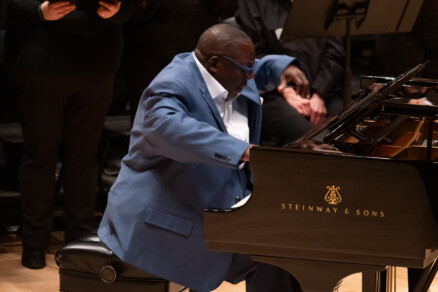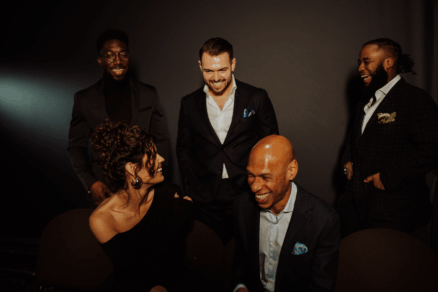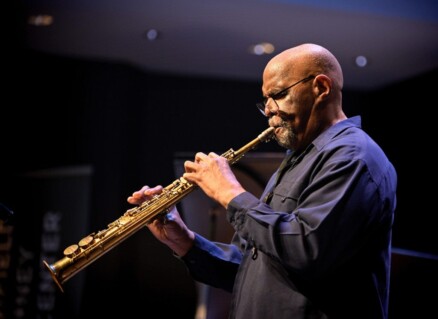Interview | Vijay Iyer, jazz’s Dr. Feelgood, wants you to be moved

When you think about interviewing one of the top jazz pianists of a generation – someone who’s proficient in electronic music and acoustic jazz, a straight-ahead innovator who’s also bringing South Indian music deeper into modern jazz’s collective lexicon – you might develop a particular set of questions to pose. Think of interviewing a college faculty member with a master’s in physics and a Ph.D in music and technology, and your mind starts to go somewhere else entirely.
Vijay Iyer, whose trio plays this Saturday in a Washington Performing Arts Society concert at the Sixth & I Historic Synagogue, is both of those dudes. As a musician, he has worked in New York City for over 10 years, with his trio and in projects with saxophonist Rudresh Mahanthappa, among other settings. Iyer puts an emphasis on pounding bass rhythms – almost like McCoy Tyner’s left hand brought up amongst a more frenetic and hip-hop-influenced generation. But there’s also something soothing about all this energy, and it has the tumbling rhythmic logic of the tala, Carnatic Indian music’s system of beat cycles.
I caught up with Iyer via email, and things got, well, kind of heady. Here are his reflections on everything from the benefits of a longstanding trio to why movement matters most.
CapitalBop: You’ve been playing for a while now with drummer Marcus Gilmore and bassist Stephan Crump, the musicians you’ll play with in D.C. What do you find rewarding about the relationship you three have forged?
Vijay Iyer: I suppose my favorite thing about playing with them is that the music feels good. At this point we have so much shared experience together, it’s just easy to make music together. And we keep pushing ourselves and each other, rethinking the obvious and trying to find new sounds and textures, so that no song is ever quite the same twice. So I find myself genuinely surprised each time that we play. That’s reward enough!
CB: Last year, you wrote a very evocative ode to Thelonious Monk in JazzTimes, talking about how he was a virtuoso innovator in terms of texture, resonance and rhythmic propulsion. Also last year, you covered “Epistrophy,” written by Monk and Kenny Clarke, on Solo. That rendition incorporated some elements of Monk’s playing, but — wisely, of course — manifested its own vision entirely. Did that cover have a particular significance, and was there something specifically that you sought to accomplish with it, sonically or otherwise?
VI: Thank you for saying that. I didn’t have a specific agenda – I suppose I’d been checking out this rhythmic structure first, and then at some point I tried this pendular harmonic progression, which suddenly reminded me of “Epistrophy,” a song that I have been playing for about twenty-five years. And then as I tried superimposing the tune over the rhythm, I found that the particular combination gave rise to significantly different melodic lines from what I was used to. Whenever I achieve a personal breakthrough like that, I try to build off of it and document it.
“Rhythm reaches into your body, grabs you, and makes you move – sympathetic vibration, you might say…”
I suppose the point is that as much as I have studied Monk’s music and piano approach, I never try to wholly emulate his or any other pianist’s playing. Instead I work with the fundamentals of music and strive for that inventive frame of mind, that feeling of discovery – because that’s just what Monk did. Indeed you can hear him doing it, time and again.
CB: You have a Ph.D in the cognitive understanding of music. If I understand correctly what I’ve read of it, your dissertation concludes, in essence, that how we hear music is deeply subjective – and influenced by our social upbringing. Also, you’ve said you’re “test-driving ideas every night when we perform” (as does every jazz musician, I suppose). How has your research affected the way you create music, and what you prioritize as a performer?
VI: That “test-driving” line referred to all improvisers, not just me, of course. To answer your question, the research put me in touch with some fundamentals about how music works. First, rhythm reaches into your body, grabs you, and makes you move – sympathetic vibration, you might say – and then as you listen, you further identify or recognize traces of human action within the musical landscape, because they remind you of your own body’s repertoire of actions. So I’ve learned to identify music with action.
Don’t get me wrong – I care very much about melody, harmony, color, sound, and emotion in music. But they are, I believe, secondary aspects of this primal, magical thing that we are all able to do — to collectively synchronize our actions through musical rhythm. So my first priority as an artist is to do that – to connect with people through rhythm and action.
I also think of “improvisation” as just another word for that larger category called “experience.” Improvisation is ubiquitous in our lives – we all improvise all the time – and yet we forget this and instead think of it as special and weird. But really the weirdest things we do are the unimprovised things: ingrained habits, overscripted conversations, operas, ballets, pageants – what Edward Said called “extreme occasions.” So I prioritize improvisation because it’s just a natural mode of being in everyday life, the very logic by which we think and move.
I should clarify – the conclusion (if there was one) of my dissertation is not quite that how we hear music is “deeply subjective” (that would seem to place it in the realm of individual choice or orientation). Rather, I tried to show how our ways of hearing are deeply conditioned by our cultural and physical experiences. There are aspects of music that we all have in common, because we all have bodies that move in similar rhythms, and human music is made by and for human bodies; and there are also aspects of music that distinguish us and our communities, in the same way that culture, language, and geography do.
CB: Those elements I identified above that you love about Monk’s playing — they come through strongly, for me, in your electronic arrangements for the excellent In What Language? album. Just got back from a Marc Cary Focus Trio show, and it was exhilarating to hear him fortify his grooves with a blend of synth, Rhodes and acoustic. Have you thought of incorporating your expertise in electronic music with your acoustic jazz stuff?
VI: I find the acoustic piano trio to be its own universe. I really like the discipline and focus of the format – there’s something almost sacrosanct about it. And there are still uncharted possibilities for sound, texture, orchestration and counterpoint in the acoustic trio. Also, I feel like I still have so much to learn about the piano – it has all these hidden curled-up dimensions I’m just starting to discern. That said, I did combine piano with Rhodes and synthesizer in my work with Wadada Leo Smith and the projects with Mike Ladd, so I’m obviously not afraid to do so. Also a few years ago I was doing solo sets with piano and laptop, which is something I may bring back soon – we shall see if the opportunity presents itself!
—
The Vijay Iyer Trio, featuring bassist Stephan Crump and drummer Marcus Gilmore, performs at the Sixth & I Synagogue on Saturday at 8 p.m. More info is available here.
Carnatic music, DC, DC jazz, jazz, Marcus Gilmore, Sixth & I Historic Synagogue, Stephan Crump, Vijay Iyer, Wadada Leo Smith, Washington


